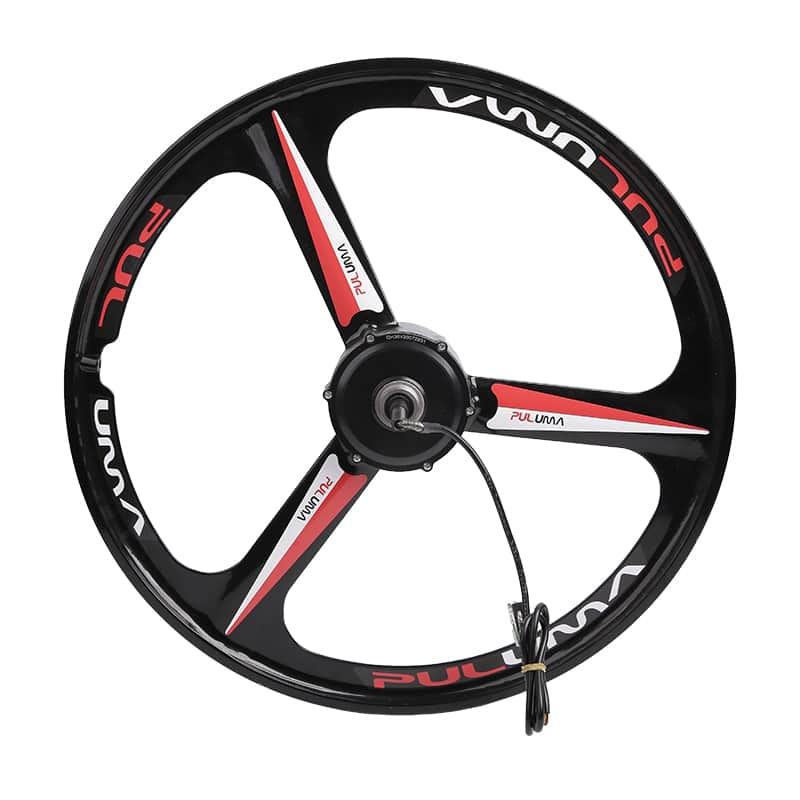

Smart logistics vehicles, such as automated guided vehicles (AGVs), autonomous mobile robots (AMRs), and delivery robots, are transforming the supply chain landscape. These machines play a crucial role in warehouses, factories, and last-mile delivery scenarios where efficiency, precision, and reliability are essential. As the demand for faster and more flexible logistics grows, the efficiency of these vehicles becomes a decisive factor for businesses striving to optimize operations.
One key technological innovation enabling this efficiency is the Motor Wheel, also commonly referred to as the in-wheel motor. Unlike traditional drivetrain systems that rely on gearboxes, transmission shafts, and belts to transfer energy, the Motor Wheel integrates the motor directly into the wheel itself. This integration reduces energy loss, simplifies mechanical structures, and allows for precise control of each wheel independently.
Efficiency is not limited to speed alone. It also includes energy consumption, maneuverability, payload capacity, safety, and maintenance costs. Motor Wheels help smart logistics vehicles excel across all of these dimensions, making them a cornerstone of modern intelligent logistics systems.
This article explores in detail how Motor Wheel technology improves the efficiency of smart logistics vehicles, the benefits it brings to different aspects of operations, challenges in implementation, and what the future may hold for this promising innovation.

A Motor Wheel is a self-contained drive unit that integrates an electric motor, wheel rim, and in some cases, additional components such as braking systems and control electronics into a single compact design. By embedding the motor within the wheel hub, it eliminates the need for traditional mechanical drivetrain components. This structural simplification brings both mechanical and operational advantages.
In traditional logistics vehicles, power is generated by a motor located centrally within the chassis. The energy is transmitted through gears, belts, or chains to the wheels. This process inherently introduces frictional losses, requires multiple components to operate in sync, and creates maintenance challenges due to wear and tear. With Motor Wheels, these inefficiencies are bypassed entirely.
Key characteristics of Motor Wheels include:
For logistics vehicles operating in dynamic warehouse environments, these features translate to better navigation in tight aisles, more efficient use of energy, and improved adaptability when carrying different load types.
Below is a simple comparison between Traditional Drivetrain Systems and Motor Wheels in logistics vehicles:
| Aspect | Traditional Drivetrain | Motor Wheel |
|---|---|---|
| Power Transmission | Through gears, belts, and shafts | Direct drive with no intermediary |
| Energy Efficiency | Energy loss due to friction | Minimal energy loss |
| Maintenance | Frequent mechanical servicing | Low due to fewer moving parts |
| Space Usage | Large central motor takes chassis space | Compact design frees cargo space |
| Control | Limited maneuverability | Independent wheel control |
One of the most significant efficiency advantages of Motor Wheels is direct drive power transmission. By embedding the motor directly into the wheel hub, energy is transferred directly from the motor to the ground without passing through gears, shafts, or belts. This drastically reduces mechanical losses. In logistics vehicles where battery power is a limiting factor, saving even small amounts of energy per cycle translates to substantial improvements in operational endurance.
Direct drive also minimizes the number of components subject to wear and tear, reducing downtime for maintenance. For logistics operators, this means fleets can remain in service longer without costly interruptions, directly increasing throughput and productivity.
By integrating the motor and wheel into a single system, Motor Wheels reduce the need for bulky central motors and drivetrain assemblies. This compact design leaves more chassis space available for cargo storage and battery capacity. Logistics vehicles benefit by carrying more packages per trip, reducing the number of trips required, and ultimately improving operational efficiency. Additionally, a lighter vehicle consumes less power, which further enhances range and energy efficiency.
Motor Wheels enable each wheel to be controlled independently. This feature provides exceptional maneuverability, particularly in narrow warehouse aisles or crowded environments. Vehicles equipped with Motor Wheels can perform precise movements, including zero-radius turns, which would be impossible with traditional drivetrains. The ability to stop and start smoothly reduces the risk of package damage and ensures safe transport of delicate goods.
Another major efficiency feature is the integration of regenerative braking systems. When logistics vehicles slow down or descend slopes, the Motor Wheel can act as a generator, converting kinetic energy back into electrical energy to recharge the battery. This not only extends the operating time between charges but also reduces overall energy consumption, supporting sustainability goals in smart logistics operations.
Motor Wheels do not simply improve mechanical efficiency; they also transform the way logistics vehicles operate on a day-to-day basis. For companies managing large fleets of AGVs or AMRs, these improvements result in measurable cost savings and productivity gains.
Reduced maintenance requirements mean that vehicles spend less time out of service. Since Motor Wheels contain fewer moving parts and no transmission chains, they are less prone to mechanical breakdowns. Predictable performance translates into smoother workflows within warehouses and distribution centers.
Improved maneuverability allows vehicles to navigate tighter spaces, which is particularly beneficial in high-density storage facilities. Operators can design layouts with narrower aisles, increasing storage capacity without expanding floor space. This flexibility improves the scalability of logistics systems.
In terms of load handling, Motor Wheels provide better adaptability for different payload weights. Since each wheel can adjust torque output independently, the vehicle remains stable and efficient regardless of whether it is carrying a light or heavy load. This adaptability minimizes energy waste and ensures consistent performance across varying operational conditions.
The total cost of ownership is reduced over time. While Motor Wheels may have higher upfront costs compared to traditional drivetrains, savings on energy, maintenance, and downtime quickly offset these expenses, making them a financially viable solution for large-scale logistics operations.